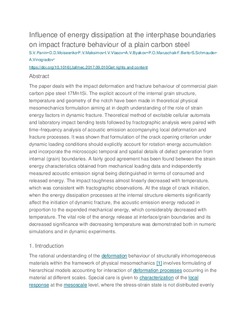| dc.contributor.author | SV, Panin | |
| dc.contributor.author | DD, Moiseenko | |
| dc.contributor.author | PV, Maksimov | |
| dc.contributor.author | IV, Vlasov | |
| dc.contributor.author | AV, Byakov | |
| dc.contributor.author | PO, Maruschak | |
| dc.contributor.author | Berto, Filippo | |
| dc.contributor.author | S, Schmauder | |
| dc.contributor.author | Vinogradov, Alexey | |
| dc.date.accessioned | 2019-02-26T13:35:46Z | |
| dc.date.available | 2019-02-26T13:35:46Z | |
| dc.date.created | 2018-11-26T10:30:32Z | |
| dc.date.issued | 2018 | |
| dc.identifier.citation | Theoretical and applied fracture mechanics (Print). 2018, 97 478-499. | nb_NO |
| dc.identifier.issn | 0167-8442 | |
| dc.identifier.uri | http://hdl.handle.net/11250/2587538 | |
| dc.description.abstract | The paper deals with the impact deformation and fracture behaviour of commercial plain carbon pipe steel 17Mn1Si. The explicit account of the internal grain structure, temperature and geometry of the notch have been made in theoretical physical mesomechanics formulation aiming at in depth understanding of the role of strain energy factors in dynamic fracture. Theoretical method of excitable cellular automata and laboratory impact bending tests followed by fractographic analysis were paired with time–frequency analysis of acoustic emission accompanying local deformation and fracture processes. It was shown that formulation of the crack opening criterion under dynamic loading conditions should explicitly account for rotation energy accumulation and incorporate the microscopic temporal and spatial details of defect generation from internal (grain) boundaries. A fairly good agreement has been found between the strain energy characteristics obtained from mechanical loading data and independently measured acoustic emission signal being distinguished in terms of consumed and released energy. The impact toughness almost linearly decreased with temperature, which was consistent with fractographic observations. At the stage of crack initiation, when the energy dissipation processes at the internal structure elements significantly affect the initiation of dynamic fracture, the acoustic emission energy reduced in proportion to the expended mechanical energy, which considerably decreased with temperature. The vital role of the energy release at interface/grain boundaries and its decreased significance with decreasing temperature was demonstrated both in numeric simulations and in dynamic experiments. | nb_NO |
| dc.language.iso | eng | nb_NO |
| dc.publisher | Elsevier | nb_NO |
| dc.rights | Attribution-NonCommercial-NoDerivatives 4.0 Internasjonal | * |
| dc.rights.uri | http://creativecommons.org/licenses/by-nc-nd/4.0/deed.no | * |
| dc.title | Influence of energy dissipation at the interphase boundaries on impact fracture behaviour of a plain carbon steel | nb_NO |
| dc.type | Journal article | nb_NO |
| dc.type | Peer reviewed | nb_NO |
| dc.description.version | acceptedVersion | nb_NO |
| dc.source.pagenumber | 478-499 | nb_NO |
| dc.source.volume | 97 | nb_NO |
| dc.source.journal | Theoretical and applied fracture mechanics (Print) | nb_NO |
| dc.identifier.doi | 10.1016/j.tafmec.2017.09.010 | |
| dc.identifier.cristin | 1634895 | |
| dc.description.localcode | © 2017. This is the authors’ accepted and refereed manuscript to the article. Locked until 30.9.2019 due to copyright restrictions. This manuscript version is made available under the CC-BY-NC-ND 4.0 license http://creativecommons.org/licenses/by-nc-nd/4.0/ | nb_NO |
| cristin.unitcode | 194,64,92,0 | |
| cristin.unitname | Institutt for maskinteknikk og produksjon | |
| cristin.ispublished | true | |
| cristin.fulltext | postprint | |
| cristin.fulltext | preprint | |
| cristin.qualitycode | 1 | |

